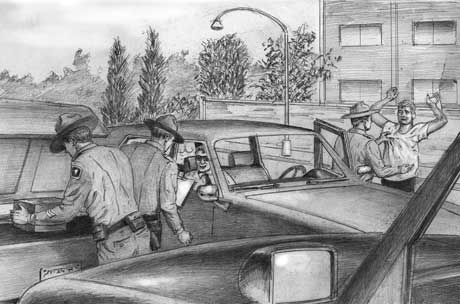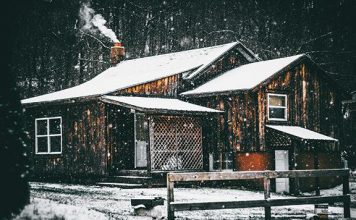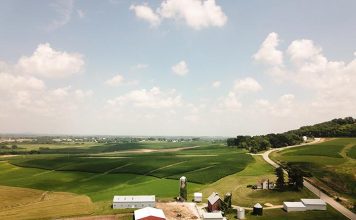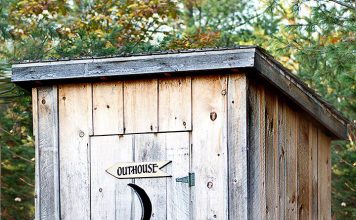| Issue #118 • July/August, 2009 |
The most remarkable thing about civil unrest is that there hasn’t been more of it.
Politicians are making a hash of this country and much of the rest of the civilized world. We know it. They know it. They know we know it. But we don’t feel we can do anything much to stop them.
That right there is the pre-condition for civil unrest when people are frustrated and politicians are nervous.
Worse, that was how things stood before last fall’s crash. Before pols on both left and right launched the biggest mass transfer of wealth in history transferring our wealth (what we had left of it!) to their friends on Wall Street and in the banking industry. In other words, that’s how things were before things got bad!
Now everybody’s talking about the ongoing catastrophe (even if we are in a momentarily sunny mood). But almost nobody is talking about the logical maybe even inevitable consequences of cynical or desperate politicians abusing an already fed-up populace: civil unrest.
I mean people taking to the streets. Or mass resistance. Or crackdowns because the government fears we might do something to upset its apple cart. It’s going to happen. Somewhere. At some time. It’s going to.
One of the few VIPs to mention the matter openly was Zbigniew Brzezinski, former National Security Advisor and the ultimate insider’s insider. He commented on the millions of unemployed or soon-to-be-unemployed and the “…public awareness of this extraordinary wealth that was transferred to a few individuals at levels without historical precedent in America.” He told “Morning Joe” Scarborough, “Hell, there could be even riots.” I’d say that’s an understatement.
|
Although few in power are talking about it, rumors abound that governments at many levels are planning for civil unrest. One rumor is about a document supposedly being circulated right now among top federal officials. It’s called the “C&R Document” with C&R standing for “conflict & revolution.” The much-storied paper is said to be a plan for controlling the American people when we get out of hand. True? Who knows. But the very rumor tells us a lot about these times.
Other things are not mere rumor. When the federal government established a North American Army command in 2002, its purpose wasn’t to repel foreign invaders. It was domestic operations something long and rightly forbidden by the Posse Comitatus Act. In February of 2009, when military commanders in Canada and the U.S. signed a pact allowing their armies to operate inside each other’s country they didn’t even bother to get authorization from Congress an illegal and unprecedented move. And once again, the purpose was handling “domestic civil emergencies.”
For several years, the Centers for Disease Control tried to get states to adopt something called the Model State Emergency Health Powers Act (MEHPA). This act would allow state governments to become police-state dictatorships in event of any ill-defined health emergency vaccinating people by force, destroying or seizing property without compensation, and rationing medical supplies, food, and fuel. To their credit, most state governments rejected the act. A few adopted portions of it before a fervent opposition campaign caused the CDC to back off. However, the concept of a health dictatorship hasn’t gone away. Not hardly. Within days of the news that a new strain of swine flu had arisen in Mexico in April 2009, states were again considering legislation to give themselves martial-law powers in event of an epidemic.
And what of the dozens and dozens of federal agencies that now have SWAT teams? Seriously, what justifies the Bureau of Land Management or the Department of Housing and Urban Development having paramilitary units?
Now maybe you like the idea of an Army that watches over its own citizens. Maybe it makes sense to have a government seize total dictatorial power in event of a health emergency. Maybe you believe SWAT teams will never be used except against bad guys. But do you really trust these people?
After all, these are the same folks, and this is the same mentality, that not only spent $325,000 to produce a souvenir photo of a presidential 747 zooming low over the Statue of Liberty, but ordered the New York Police Department, the FBI, the Secret Service, and the New York mayor’s office not to tell the public. Never mind that they realized full well that passenger jets and military planes plunging low over Manhattan would evoke panic.
Still, peace reigns. Mostly. At least here in North America. But not everywhere. Not long ago, France was brought to its knees by night after night of rioting. In that country it’s become almost common for workers to hold their bosses hostage in hopes of winning economic concessions. Greece, too, saw its normal life and business shut down by days of rioting. So did Iceland a country that’s normally the picture of civility.
Can the U.S. be forever immune?
It might not take much and it could be something out of the blue, something impossible to anticipate to set us against each other and against the “Trust us; we’ll fix it” political crowd.
In a way, this national silence on a matter so many people are afraid of is similar to the silence about general preparedness issues before 9-11 or Hurricane Katrina. Only Mormons and us wingnuts spoke of preparedness way back when. Since then, of course, advice on preparedness is mainstream and common.
In another sense, this silence is different. Because when unrest finally erupts, it’s not going to be us merely taking care of ourselves. It’s going to be “us against them.” It might be workers against bosses. Or the poor against bankers. Or blacks against Hispanics. Or little folk against Big Men in public office. Or farmers against the USDA. Or xenophobes against xenophiles. But however it happens, the implications aren’t as Boy-Scoutish as just taking care of ourselves in an emergency.
|
Defining civil unrest
Look up “preparations for civil unrest” on Google and…What’s that echo I hear?you’ll find nothing that’s going to help you. In fact, you won’t even easily turn up a good definition of what civil unrest is.
Like “indecency,” the definition seems to be in the eye of the beholder.
I wouldn’t consider a peaceful anti-war march to be civil unrest, for instance, but a police chief might. Similarly, I wouldn’t consider acts of localized non-violent lawbreaking (like environmental activists chaining themselves to a tree) to be civil unrest; but a timber company official probably believes otherwise.
Civil unrest occurs when anger, frustration, or fear turn disruptive on a mass scale. Or when government officials crack down because they anticipate such disruptions. Crackdowns can lead to further frustration, leading to further crackdowns and so on especially when the crackdowns look unwarranted and tyrannical.
In other words, civil unrest can arise from the anger of people or the folly of government or both together.
Anger over an unpopular policy, a new war, a collapse of the currency, panic over a pandemic, a food shortage, a bank run anything like that could cause civil unrest, especially in a population that’s already on edge and no longer trusts its authority figures.
Another thing you won’t find via Google is how various types or levels of unrest are likely to affect us and how we should respond, if we’re affected. Again, although the men and women at the top are quite concerned for their own sakes, they (and their media mouthpieces) would rather not talk about what we should do in event of civil panic.
But that’s not good enough for we independent-minded people, is it?
Here are my definitions of levels of civil unrest and a little bit about how they might affect us:
LEVEL ONE: The lowest level of civil unrest is when people turn on their own neighborhoods as happened during the race riots of the 1960s and the Rodney King riots in Los Angeles. Level One civil unrest can be deadly and destructive, but primarily to people who live, work, or must travel in the immediate area. Level One unrest is spontaneous, Dionysian, is confined to a narrow geographical zone where the protestors live. Police response may be harsh, but it’s localized. Unless you’re in the middle of it, you’re unaffected.
LEVEL TWO: Level Two civil unrest may also be focused on a single area. But in this case, rioters or protesters have deliberately targeted a business district, a facility, a transportation system, or an organization to impose maximum disruption. One example: the World Trade Organization protests in Seattle in 1999; young people with violence in mind and rage in their hearts attacked an entire downtown, affecting hundreds of businesses and tens of thousands of workers who hardly knew what hit them. Another example: This spring, protesters in Thailand shut down the Bangkok airport, affecting who knows how many individuals and businesses. Level Two unrest is usually planned or semi-planned. The target is chosen deliberately. Although still focused in one area, Level Two can disrupt normal life and business in a whole region or country.
LEVEL THREE: Level Three comes when mass unrest or authoritarian crackdown causes disruption at state or regional level. Then, no matter what the original cause or location of the trouble, everyone in the region is affected. Effects might include travel restrictions, random ID checks, mass arrests, food and fuel rationing, controls on money and banking, roadblocks, and other harsh “emergency” restrictions.
LEVEL FOUR: Level Four is Level Three but on a national or even international scale. It’s martial law. If things ever get this bad, it’s likely that the government itself will be a far bigger threat to everyone’s well being than whatever the original cause of the clampdown was.
And of course, any level of civil unrest can lead to laws, regulations, and harsher police policies that end up affecting everybody in the long run.
|
Yes, it can involve us
We make a mistake if we think civil unrest is strictly an urban phenomena. It can happen anywhere.
When 400 government agents and soldiers descended on one isolated family in the Idaho mountains, the roadblocks, helicopters, Humvees, media presence, and furious protestors surrounded the Randy Weaver family and brought the normal life of Boundary County, Idaho, to a halt. The siege against the Branch Davidian church in Waco, Texas, wasn’t conducted in the inner-city, either. Yet both of these were large scale catastrophes with all the hallmarks of civil unrest individuals or groups resisting, government insisting.
I can easily envision strictly rural-based unrest that urban dwellers will never even hear about (except perhaps in highly distorted reports). What happens, for instance, if farmers, 4H families, owners of saddle horses, and holders of small chicken flocks decide to resist en masse the National Animal Identification System (NAIS)? It’s easy to imagine, in these crazy days, USDA SWAT teams descending on the countryside to make arrests, forcibly register or destroy non-compliant animals, and burn down non-registered facilities.
The future could see rural resistance to invasive census-taking, forced vaccination programs, land takings, water-rights policies, or the destruction of herds for real or bogus health reasons. As country people increasingly see governments as foreign organizations driven by the interests of city dwellers, pharmaceutical companies, and mega-agri-business, it wouldn’t surprise me.
If we ever have serious food shortages, expect rural areas to be besieged.
Even when civil unrest confines itself to the cities, airports, or highways it can affect us in crazy ways. Here’s a funny example of unpredictable (in this case mild) consequences. A friend was due to have her first book published in Canada. She was very excited then disappointed when weeks dragged by and the book didn’t appear. Turns out that a band of Indians was blocking a highway bridge the printer’s truck had to cross. The union truckers, in solidarity, refused to route around the protest. Just one small consequence. But you can see the unpredictability.
The simple truth is that we don’t know what kinds of unrest to anticipate. We don’t know when, or if, we’ll see civil unrest. But thinking about the problem and preparing ourselves mentally and physically to deal with it should be just another aspect of our personal preparedness.
What we can do
1. Keep standard emergency preps up to date. First thing to do is make sure all our typical household preparedness supplies and plans are current. As BHM readers know, backup food, water, and other supplies are our mainstay for everything from bad storms to long-term unemployment, from power outages to social breakdowns. During civil unrest, especially at Level Three or Four, we might not be able to get out to buy things we need or we might consider it more prudent to stay at home. On the other hand, if we ourselves are part of the unrest, we may need those supplies to sit out a siege.
2. Don’t fall into foolish complacency. We who live in the country tend to have an “it can’t happen here” attitude toward political violence or social upheaval. We see those things as urban pheonomena. And mostly, they are. But there’s no ironclad rule that says they have to be. If anything disrupts the supply chain, for instance, rural areas could be the first to be cut off from food, medicines, fuel, or other necessities. If government breaks down to the point where it can’t deliver food stamps, housing vouchers, social security, or bureaucrats’ pay, the rural poor and unemployed could become just as restive as their urban counterparts.
3. Watch your health. As I write this, the airwaves are shrilling about swine flu. This outbreak may fizzle; after all, perfectly normal flu kills many every year without causing panic, martial law, or incessant media coverage. On the other hand, it’s certain that one day some illness will rampage across the globe. Few things inspire public panic more quickly than contagious disease, and once again rural areas are not immune. Take all the standard recommended precautions like frequent handwashing. Make sure your preparedness kit includes surgical masks and disposable gloves as well as a selection of frequently updated medications. And be ready to lay low at home for a long time in the event a serious plague gets loose.
4. Make common cause with your neighbors. I’ve said it before, but establishing a strong bond with people in your community right now is vital to every sort of emergency preparedness. In event of a Level One or Two emergency, these are the folks who could come to your house to make sure you’re okay. They might give you a ride out or a place to sleep if you accidentally end up in a “hot zone” of riot or protest. In a deeper or more long-term emergency, they could pool resources with you to make supply runs. They can advise you if they’ve spotted a roadblock. They might let you cross their land to avoid a route that has become dangerous.
5. If you grow crops or raise food animals and the unrest is due to a food shortage (or something has driven city people out into the countryside), prepare to protect your resources day and night. Here again neighbors can do each other valuable services, like taking shifts guarding fields, barns, private roads, and gardens. Yes, this is an apocalyptic scenario. Not a likely one. But if it happens, it’s a Level Three or Level Four emergency delivered to your own front yard.
6. Get advance word on local conditions when traveling. We’re used to hopping into our vehicles or onto airplanes and going wherever we want to go. But as the worldwide economy deteriorates, it’s wise to keep an eye on our destination. Right now, this warning pertains more to overseas travel than jaunts within the U.S. If you plan to go abroad, visit online sites like Travelfish.org. They’ll have bulletins about adverse conditions in areas you plan to visit; you may even be able to receive alerts via email that will warn you about anything from political protests to disease outbreaks in places you plan to go.
7. Watch for signs of trouble when in an unfamiliar area. Sometimes the only advance notice you get is the notice your own senses give you. When walking, driving, biking, or otherwise traveling in unfamiliar places, stay in what gunfolk call “condition yellow.” This is different than the meaningless colored threat levels the Department of Homeland Security puts out. It just means “be alert!” Never simply allow yourself to slouch along obliviously. Always be aware of who’s nearby and what’s going on around you. If you spot trouble developing, turn. Avoid it if at all possible.
8. If you stumble into a “hot zone” of unrest, be prepared to think on your feet. Not many people are qualified to give you advice about how to behave if you unavoidably find yourself in the midst of trouble a riot, a mass protest that suddenly engulfs your familiar downtown, a spot where police are bashing heads or hurling tear gas seemingly at random. That’s because not many people have ever been there and every catastrophe is different. If street-level chaos surrounds you, do your best to keep a cool head, move away from the worst of it if you get the chance, and get inside if possible.
9. If you’re swept up in mass arrests during a riot or demonstration, the officers probably aren’t going to be listening to your protestations of being an innocent bystander. You’ll only tick them off and possibly get a charge of resisting arrest. The best advice I’ve received from my friends who’ve been busted during out-of-hand protests: Go along as best you can. Usually, all charges in such cases are either dropped or reduced once calm is restored. Only if we’ve reached the extreme point where police are rounding people up and throwing them into detention camps or “disappearing” them is fighting cops on the street likely to be worth it; then…fight like a demon.
10. Have a good lawyer and carry his or her card with you. Once again, in the heat of chaos it may not do you much good. But that card will come in handy later. Besides, if you and a police officer have an encounter in calmer circumstances, a lawyer’s card, along with your calm assertion of your legal rights, will help you to be taken seriously. Police officers are like anybody else; they’re more likely to go after easy targets than ones who are obviously knowledgeable and prepared. My lawyer has a helpful little list on the back of his card of the things you should do and not do when accosted by a police officer.1 I’d trust that more than my own nerves in a tight situation.
11. Be careful of roadblocks. This is a hard one. If we reach Level Three or Four of unrest, we may not only see the obnoxious police “checkpoints” we’re burdened with today. We might also see two other things. One would be expanded police roadblocks, with warrantless searches, harsh questioning, and possibly mass arrests. Another could be “freelance” roadblocksroadblocks set up by anybody from political protesters to highwaymen. (Just as gangs of home invaders now masquerade as SWAT teams, highwaymen might masquerade as government officials to rob the unwary.) If it’s humanly possible, avoid roadblocks. It’s not illegal to turn away from them, as long as you don’t disobey any traffic laws. Police do consider it suspicious behavior and may come after you, even if you’ve done nothing wrong; but in a time of civil unrest, avoiding a roadblock could save your skin. Of course, both police and freelancers will set up their blockades to make them as hard as possible to avoidall the more reason to be alert, know where roadblocks are likely to be, and have a mental map of alternate routes. If, in a time and place of unrest, you’re in a line approaching a roadblock, watch what happens to the people ahead of you. If you see any sign that the motorists ahead are being abused, get out of there.
|
So far, we’ve talked mostly as if civil unrest is something apart from us something we might have to be wary of, something we might stumble accidentally into. But the fact is that as our country becomes less free, we might of course be the civil unrest.
We might resist having our premises tagged for NAIS or having our herds slaughtered for real or bogus health reasons. We might end up fighting evictions (as farmers and many rural dwellers have for centuries during hard times). We might be the ones who say, “Hell no, we won’t go!” when the mobile vaccination van comes to town, or the ones who try to keep our neighbors from being rounded up and sent to camps. Times are uncertain. We simply don’t know.
But in every case, preparedness, foreknowledge, and a cool head will come in handy.
Some of us already have lines in the sand that would inspire us to resist abuses of authority. And that, right there, is something our would-be masters fearour disobedience. What will happen? And when? Nobody has a crystal ball. But the combination of public frustration and governmental apprehension is an explosive one. Someday, somebody will light the match.
1 Here’s the copy on the lawyer’s card (capitalization his):
|
I’ve had several different lawyer’s cards over the years that say similar, but slightly different things. Another great source of information on how to handle yourself when confronted by police is the DVD Busted: The Citizen’s Guide to Surviving Police Encounters. It’s great because it shows very realistic scenarios and coaches you vividly on how to navigate them. Clips from “Busted” are online at the link above.



















This article couldn’t be more timely given the garbage draconian restrictions due to COVID; ANTIFA/BLM riots and the 2020 election fiasco. All of these are individual powder kegs waiting for the right (or wrong) match.
Did you notice the dates in this article? Interesting, seems prophetic of recent times.
Good and thorough article. Your “level one” I heard repeated in a you tube video of a lady from Yugoslavia. She said communism seeks division, first by pitting neighbor against neighbor (informists). Even in my own household, this man and wife see covid quite differently; and we’re both christians! Division.